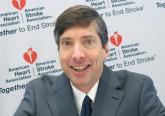Conference Coverage


This is enormously exciting. It shows that all these efforts to improve treatment time, the door-to-needle time, have a payoff. The patients did better. It shows that these interventions matter.
What strikes me is that there’s no single magic intervention. There’s no high technology or amazing breakthroughs. It’s just by making every step in the process a little bit better.
| Dr. Steven Greenberg |
Another message is that you can always get better. You’re never done.
This will be an ongoing effort. I don’t think you’ll see any single breakthrough but hope you’ll see small improvements and small improvements, but ones that really impact people’s lives.
Dr. Steven Greenberg, professor of neurology at Harvard Medical School in Boston, was chairman of the International Stroke Conference Program Committee. He was not involved in creating or studying Target: Stroke and reported no relevant disclosures.
AT THE INTERNATIONAL STROKE CONFERENCE
SAN DIEGO – The percentage of patients arriving at hospitals with ischemic stroke who were treated with tissue plasminogen activator within the recommended 60 minutes increased from 30% to 53% on average at 1,030 hospitals engaged in the Target: Stroke program in the past 4 years.
Average time from arrival to treatment showed a significant decrease of 15 minutes, from 74 to 59 minutes. Clinical outcomes confirmed Target: Stroke’s motto that "time lost is brain lost," showing significant improvements in rates of death, symptomatic intracerebral hemorrhage, and the likelihood of being discharged home, Dr. Gregg C. Fonarow and his associates reported at the International Stroke Conference.
The study analyzed data on 71,169 patients seen for ischemic stroke at U.S. hospitals that implemented the Target: Stroke program, comparing practices and outcomes before the program launched (2003-2009) with data from after program implementation (2010-2013) and adjusting the results for patient and hospital characteristics.
Average in-hospital mortality decreased from 10% in 27,319 patients seen before Target: Stroke to 8% in the 43,850 seen after the start of the program. The proportion of patients discharged home increased from 38% to 43%, rates of symptomatic intracranial hemorrhage decreased from 6% to 5%, and complications from tissue plasminogen activator (TPA) treatment decreased from 7% to 6%, said Dr. Fonarow, chair of cardiovascular medicine and science at the University of California, Los Angeles.
After adjusting for the effects of multiple other factors, the risk of dying in the hospital decreased 11%, the risk of symptomatic intracerebral hemorrhage or TPA complications each decreased 17%, and the odds of being discharged to home increased 14%, all highly statistically significant and clinically significant outcomes, he said.
These gains were seen in secondary analyses in all subgroups, including men and women, patients older or younger than the median age of 72 years, patients with lesser or greater stroke severity, and patients of different races and ethnicities, he said at the meeting, which was sponsored by the American Heart Association (AHA).
Target: Stroke is a nationwide quality-improvement initiative launched by the AHA and the American Stroke Association (ASA) in 2010 that identified 10 evidence-based strategies that are associated with timely stroke reperfusion and are feasible for hospitals to implement rapidly and cost effectively, Dr. Fonarow said.
The project also supplied clinical decision support tools, performance feedback, and other tools to help hospitals reduce door-to-needle times to less than an hour for most ischemic stroke patients. He and his colleagues described the design and rationale of the initiative in an earlier article (Stroke 2011;42:2983-9).
Only 16% of U.S. hospitals had door-to-needle times of 60 minutes or less in 2009, right before Target: Stroke launched. By 2013, that proportion "increased markedly" to 47% of participating hospitals meeting this benchmark, he said. In 4 years, the project achieved its goal of having at least half of ischemic stroke patients get TPA within an hour of arrival, which would have taken 15 or more years if rates of progress before Target: Stroke had persisted.
The AHA/ASA set a new target for phase II of Target: Stroke, which was launched at the meeting: Reducing door-to-needle times to less than an hour for at least 75% of ischemic stroke patients at participating hospitals.
The current study controlled for the effects of age, sex, race, history of atrial fibrillation, prosthetic heart valve, previous stroke or transient ischemic attack, coronary heart disease or prior MI, carotid stenosis, peripheral vascular disease, hypertension, dyslipidemia, current smoking, stroke severity, arrival time and mode, onset-to-arrival time, hospital size, region, annual volume of TPA, annual stroke discharge, and whether the facility was a teaching hospital or a certified stroke center.
Dr. Fonarow said that it was not feasible to include a true control group of hospitals that did not join the program because the lack of participation in nationwide quality improvement programs makes it difficult to gather data from those facilities.
He and his associates previously reported that, before Target: Stroke, most U.S. stroke patients were not receiving TPA within an hour of arrival at a hospital (Circulation 2011;123:750-8).
Dr. Fonarow and one of his associates in the study are employees of the University of California, which holds a patent on retriever devices for treating acute stroke. Five of his coauthors reported financial associations with multiple companies, some of which make treatments and devices for stroke.
On Twitter @sherryboschert

